Yugioh 1st Edition 1st Print Run Lob Blueeyes
PSA Set Registry
Collecting the 2002 Yu-Gi-Oh! Legend of Blue-Eyes White Dragon
The First Yu-Gi-Oh! Trading Card Game Set
By Anthony Ghezzi
Nostalgia is euphoric, and for Yu-Gi-Oh! collectors there is nothing better to collect than the first set released in North America, the Legend of Blue-Eyes White Dragon.
That's how leading Yu-Gi-Oh! collector, Ian Douglas, described the 2002 Legend of Blue-Eyes White Dragon (LOB) set. One of the genre's most knowledgeable collectors, Douglas maintains an extensive collection that he shares with the hobby under his YouTube pseudonym, The Old-School Expert.
"LOB lays the groundwork for the Yu-Gi-Oh! collectors' market," he said. "As the first set ever released in this trading card game (TCG), it sets a precedence. But it was more than just the first set. LOB included rare variants of some of the show's most beloved monsters such as Yugi's Dark Magician, Joey's Red-Eyes B. Dragon and Kaiba's Blue-Eyes White Dragon."
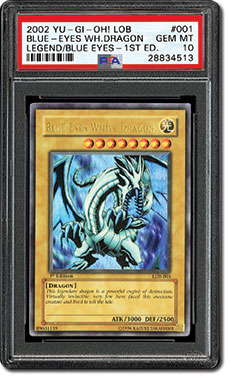
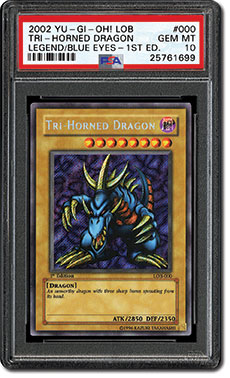
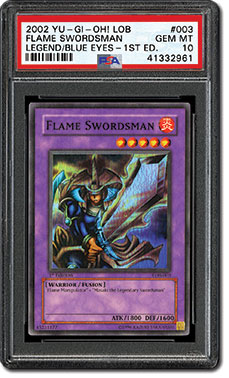
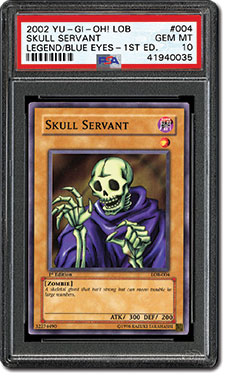
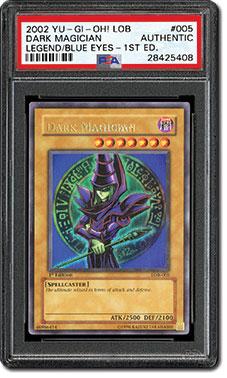

Lewis Nugent, who goes by "Vintage Yugioh" on both YouTube and Instagram, feels similarly about the classic set. "LOB is the base from which all other Yu-Gi-Oh! sets begin," he said. "Without its success, I believe there would be little of value beyond the first few sets in the game."
For those who were active players early on in Yu-Gi-Oh!, this set introduced many cards that were not only aesthetically pleasing but also had far reaching playability. Many are even considered staples of the game as they are played in all decks, no matter the type.
"LOB is also remembered by those who played competitively because it introduced a plethora of indispensable dueling cards like Raigeki, Monster Reborn, Pot of Greed, and the only automatic win condition in the game - Exodia the Forbidden One," said Douglas.
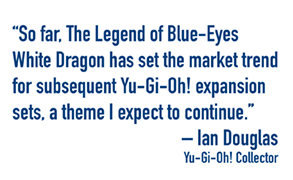
The cards feature a black border, an attribute, level stars signifying the tribute requirements for the card to be summoned, a set and number, a "1st Edition" stamp on some, text box, attack and defense, a card identification number and The Eye of Anubis, which is either gold for 1st editions or silver for others.
Legend of Blue-Eyes is the first in a series of eleven TCG sets that are considered "classic" among Yu-Gi-Oh! players. For TCG sets, LOB introduced what became the standard number of secret rare, ultra-rare and super-rare cards issued within each set. From LOB through Ancient Sanctuary, the 11th Yu-Gi-Oh! release, the set construction of two secret rares (the first and last card in each set), 10 ultra-rares, and 10 super-rares was maintained, though the number of rares and commons varied from set to set.
Classic sets yield two ultra and four super-rares per box. A key difference from other TCGs is the "Short Print" (SP) and "Super Short Print" (SSP) designation on specific common cards. These cards, like secret rares, never had an acknowledged insertion rate. Most collectors believe there to be one or two SPs and SSPs per box, although that is no guarantee. They can be as difficult to find as some of the holographic cards. Lastly, secret rares typically appear in two of three boxes. For those hardcore box breakers out there, these ratios are not guaranteed. A fraction of boxes yield no holographic cards, while others, considered "God Boxes," pay out a holographic in each pack.

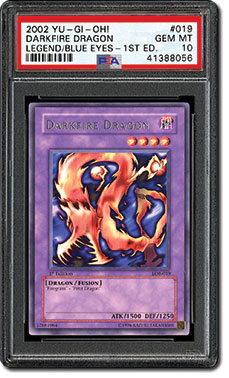
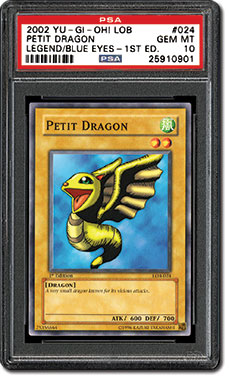

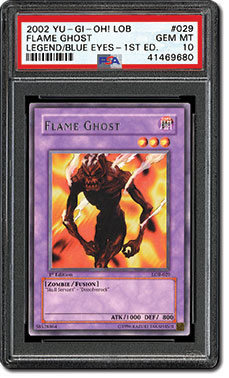
The parent corporation that released Yu-Gi-Oh! is Konami, or officially known as Konami Holdings Corporation. Launched by Konami in 1999, the Official Card Game (OCG) was solely available in the Japanese language until the TCG release of LOB in North America in March 2002. With the TCG's release, Yu-Gi-Oh! started down a path that would lead to it being named the top-selling TCG in the world by the Guinness World Records in 2009.
While LOB is the first set in the TCG, it is a composite of two sets previously released in the OCG. The sets that comprise LOB were released in 2000 under the names Legend of Blue-Eyes White Dragon (LB) and Phantom God (PG). When determining the layout of LOB, Konami decided to combine both LB and PG and changed a few rarities between the two OCG sets to create the first TCG set, Legend of Blue-Eyes.
TCG cards differ greatly from their OCG counterparts, which had a much smaller text box and a glossy finish on the front and back. A portion of LOB display this glossy finish; however, another batch of LOB was distributed with a different cardstock that is known in the community as "wavy." This was not necessarily an intended variation by the producers, but it has become one that is very much acknowledged by collectors today.
These "wavy" cards often fetch a premium among die-hard collectors, as many hypothesize that they represent just one-third of the total First Edition population. Legend of Blue-Eyes First Edition boxes were released with three known variations, each yielding a different secret rare unique to the box. Only one of these boxes yields the "wavy" variety with Tri-Horned Dragon as a box secret. The other two yield glossy cards: one with Gaia the Dragon Champion and the last with Tri-Horned Dragon.
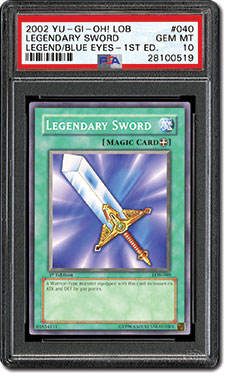
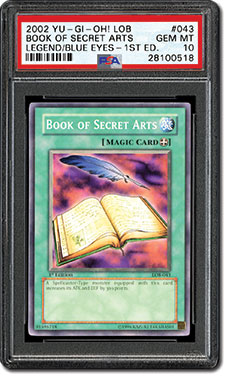
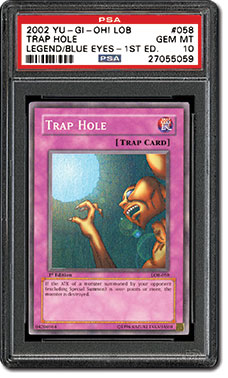
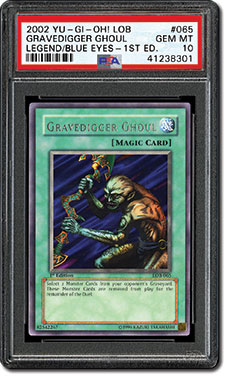

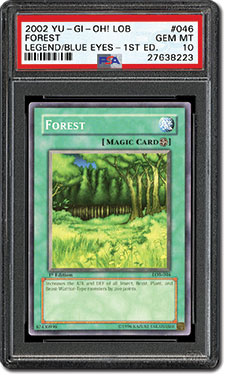
A study of the PSA populations for both secret rares indicates that Gaia the Dragon Champion is submitted approximately once for every two Tri-Horned Dragon submissions. To many collectors, this is simply another indication that Gaia the Dragon Champion may represent half the production of its counterpart. To more than a few collectors, it substantiates that while there are extant glossed sheets with both secrets, another production run may have been made with different card stock and consisting of only Tri-Horned Dragon secret rare cards. Collectors still argue over whether that production run came before or after the glossy card production.
"Quality control was questionable for this set," acknowledged Nugent. "There were multiple card stocks used during the printing of this set, which created 'wavy' foil and 'glossy' foil versions, although Gaia the Dragon Champion was only printed on glossy card stock for unknown reasons. Both stock versions have centering issues and lots of cards have ink splotches, factory lines, square cut corners or white edge dings directly from packs. The overall color of the cards also varies greatly from very light to very dark for the same card."
As a result, many cards pulled from packs are not worthy of a PSA GEM-MT 10 grade, but this has not deterred people from either grading or collecting these cards. Legend of Blue-Eyes has the highest submission rate among sets and retains some of the highest per-card populations for the genre. This appreciation for less-than-perfect cards indicates that the market is strong for examples in grades less than gem-mint 10, with many super rares selling well over $100 each in PSA MINT 9.
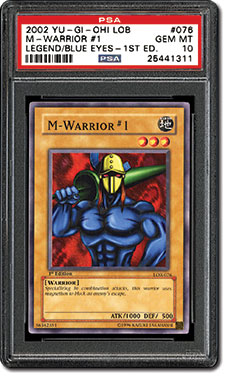
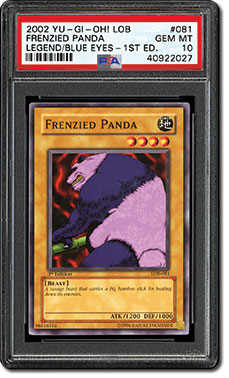

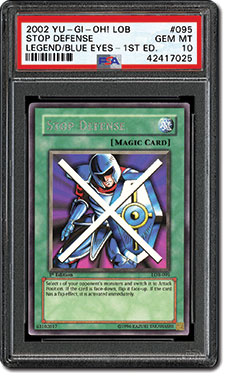
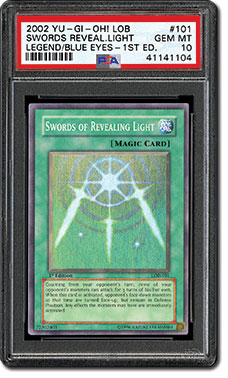
An unfortunate result of the popularity of these cards has been that an abundance of forgery boxes has been produced in recent years, most of them coming out of Hong Kong and all with the small font "1st Edition" showing. The easiest way to determine authenticity is by looking at the green Upper Deck Entertainment logo on the back of the box. If the letters are indistinguishable under magnification, the box is not authentic.
Despite these disruptions, Douglas has seen the market for these cards continue to grow. "So far, LOB has set the market trend for subsequent Yu-Gi-Oh! expansion sets, a theme I expect to continue," he said.
Recently prices have spiked as sales for PSA 10 Blue-Eyes White Dragon cards have exceeded $5,000 more than seven times since December 2018, with wavy examples selling at even higher prices. These are uncharted waters for longtime Yu-Gi-Oh! collectors. "The first PSA 10 Blue-Eyes that I remember ever seeing sold was in March 2015 for $999. This was basically the starting price for these cards, as I recall," said Douglas.
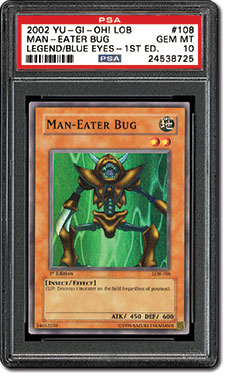

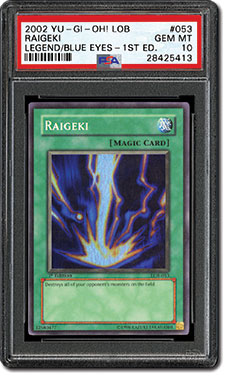
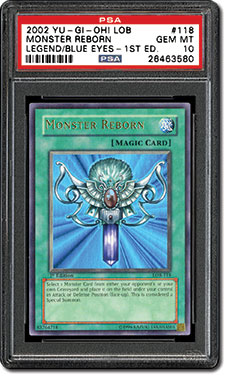
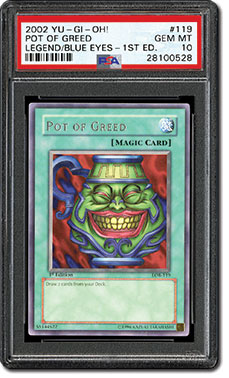
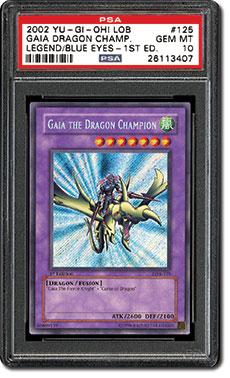
The five most popular cards in this set are Blue-Eyes White Dragon, Red-Eyes B. Dragon, Gaia the Dragon Champion, Flame Swordsman and Exodia the Forbidden One. These cards tend to lead the market in their respective rarities. While Blue-Eyes leads the set in general, Red-Eyes B. Dragon is often not far behind with sales between $2,800 and $4,000. Gaia the Dragon Champion leads as the prominent secret rare since its population is generally 30% that of Tri-Horned Dragon. If you can find one, examples trend between $1,500 and $2,200. Flame Swordsman is the predominate super rare in the set typically selling between $600 and $950 or twice the price of other super-rare cards.
Exodia the Forbidden One is a special card in the TCG, requiring four other cards (two arm pieces and two leg pieces) to be used for an automatic victory in a game. It is the composite of five "Forbidden One" cards, represents half of the ultra-rare cards available in LOB and is considered one of the most formidable characters in the anime. Each of the five cards is printed as an ultra-rare and considered a "piece" of Exodia. Since a box typically yields only two ultra-rare cards, collectors are very unlikely to complete the set by purchasing even three boxes.

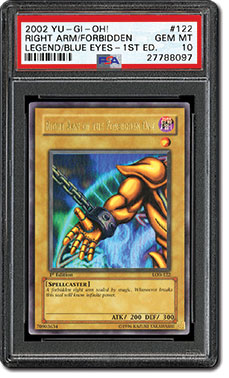
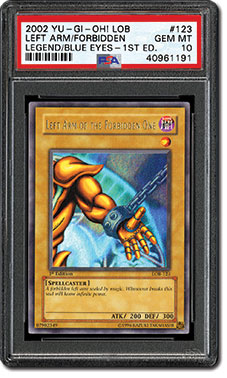

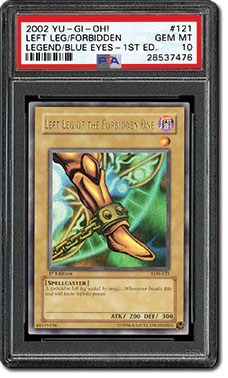
Estimates for complete gem-mint Exodia sets stem between 15 and 20, or about 60% of the possible sets. The lowest population card is consistently the Left Arm of the Forbidden One, with a population of 33 in PSA 10. Many collectors own pieces of the set; however, owning all five in gem-mint condition is a small feat in itself. Complete sets are typically valued between $4,500 and $6,500 depending on the composition of the card stock.
For boxes, the story is the same. "Nothing is hotter in Yu-Gi-Oh!," said Nugent. "Higher single-card prices have driven up the pricing of sealed packs and booster boxes. There seems to be no limit on the potential of these cards." No doubt, this is true. As early as 2010, boxes of LOB could be purchased for as little as $150. By 2013 they were $550. In 2016 they reached as high as $1,300. Just recently a small print box of LOB sold privately for $8,500, outpacing its large print sibling by $3,000. eBay listings display sales even higher than that, leaving many vendors doubtful that small print boxes will ever be lower than $10,000 in the future.
No matter what segment of the hobby most interests a collector, everyone maintains a certain reverence for the first set in their area of interest. For Yu-Gi-Oh! players and collectors, this is Legend of Blue-Eyes. It is the trading card game's inaugural set and introduced a series of cards that are attractive to both players and collectors alike.
For more information on 2002 Yu-Gi-Oh! Legend of Blue-Eyes White Dragon gaming card set, please visit PSA CardFacts.
Anthony Ghezzi is a Yu-Gi-Oh! expert, collector, PSA Set Registry member and contributing writer to the SMR. A special thanks to SMR staff writer Todd Tobias for assisting Ghezzi in the composition and editing of this article. Please note that any pricing, PSA Population Report statistics and/or Set Registry rankings referenced are as of May 2019.
Source: https://www.psacard.com/articles/articleview/9908/psa-set-registry-collecting-2002-yu-gi-oh-legend-blue-eyes-white-dragon-first-trading-card-game
Belum ada Komentar untuk "Yugioh 1st Edition 1st Print Run Lob Blueeyes"
Posting Komentar